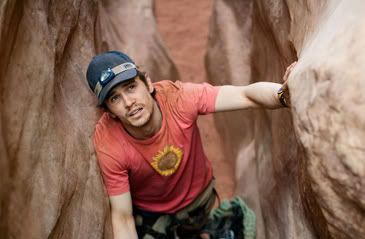

"127 Hours" (2010)
In April 2003, 27-year-old outdoors enthusiast Aron Ralston (James Franco) took a trip to indulge in his favorite activity of escaping miles and miles away from civilization. He traveled to the winding red rock formations of Blue John Canyon in Utah and failed to tell anyone where he was going. There, he fell and got himself trapped inside a small crevice with his arm crushed and wedged between a rock wall and a heavy boulder. How could the predicament of this man's entrapment and escape be made into a 90-minute film? Only through the visual genius of director Danny Boyle ("Slumdog Millionaire").
The film is both harrowing and entertaining, and from its very opening, it's also very much a Danny Boyle film. Our introduction to Aron serves also to introduce us to Boyle's keen visual style that will later be used to punctuate pivotal moments in Aron's struggle. Boyle sends us into the desert in a rush of flashy cinematography from the gifted Anthony Dod Mantle, who also worked on "Slumdog Millionaire," and Enrique Chediak. Also hailing from his work on "Slumdog Millionaire" is A.R. Rahman who returns with a driving score to fit the kinetic and breathless energy that Boyle pumps into each frame.
Boyle has a knack for bringing vivacity and life to dire and ugly situations. From heroin addiction in "Trainspotting" to poverty and violence in "Slumdog Millionaire," his films are exuberant and invigorating. His new film, "127 Hours," is perhaps the toughest challenge taking a story strictly confined to one man and one space and turning it into an experience that is completely visionary and transporting. Based on Aron Ralston's own memoir, "Between a Rock and a Hard Place" and adapted by writer Simon Beaufoy ("Slumdog Millionaire"), it's a film that is immediately compelling, a survival tale about psychological and physical endurance and desperation.
It helps that James Franco is such good company. This is his one man show, and he is astounding. From a cocky explorer to a helpless victim having to shed his pride, the transformation could not have been portrayed any better, and Franco disappears in the role and gives us his most demanding screen presence yet. Franco doesn't create a hero, either. He plays a man who was foolish enough to get himself trapped in a horrible situation but also intelligent enough to know how to get himself out.
The last people to see Aron are two attractive young hikers, Kristi (Kate Mara) and Megan (Amber Tamblyn), who appear to be lost. Aron takes the opportunity to boast about his knowledge of the area and offers to be their tour guide. He takes them to an underground hot spring, a temporary paradise. Aron's show-offish and reckless behavior here, however, is a tease for his avoidance of danger, a premonition and ironic forewarning of what's to come.
Once stuck, we soon get familiar with Aron's space. He sets his watch, rope, water bottle, camcorder, camera, other assorted items and, most importantly, that blunt knife of his on top of the boulder and fashions a pulley to keep himself hoisted up and keep pressure off his feet. There is a strip of sky above him where every morning around the same time a large bird flies past. He gets only 15 minutes of sunlight each day. He spends his time chipping away at the boulder with his knife and begins talking to himself on the camcorder.
Through imaginative storytelling, we also occasionally escape Aron's space. We enter into memories of his family, parents (Kate Burton and Treat Williams) and girlfriend (Clémence Poésy). We descend into fantasies and hallucinations, as well, such as a trippy montage of drinks as a vivid evocation of Aron's thirst, and these really embed us into his state of mind. At his core, Aron is a good-natured goofball. In one instance, he pretends to be on a talk show while recording himself, and he even includes audience response referring to his predicament as an "oops" moment. We all have those moments. Except this one could get him killed. Oops.
There are some gut-wrenching and intense scenes. Most notably the one the audience waits for in nervous suspense, the moment Aron decides to cut through his arm. It is a powerful scene and not gratuitous. The editor, Jon Harris, does an admirable job of showing us the procedure without actually showing us. What becomes the worst part is actually a sound rather than a sight. The scene communicates something larger than just a jolt of discomfort because at this point in the movie, we have lived vicariously through Aron and feel his pain.
Even more, "127 Hours" culminates to an inner monologue from Aron where he addresses the guilt of his selfishness. He thinks back realizing this rock had been waiting for him his entire life. All of his actions and choices had been leading up to this single moment. Cutting off an appendage was not only freeing himself physically but freeing himself spiritually in a moment of existential bravery and poignancy.





No comments:
Post a Comment